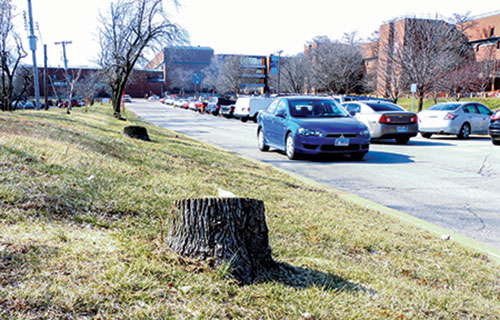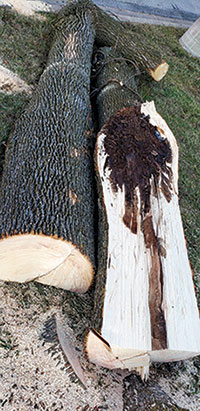
By Mackenzie Gregory
The Scene staff
Forest Park is losing its forest.
The college has cut down more than 30 trees on campus, leaving only stumps. Officials blame beetles called emerald ash borers, which have been slowly killing them.
“The tree looked perfect,” said Manager of Facilities David Christensen, describing one tree that was cut down. “It split open when it fell. It was completely rotten on the inside.”
It’s believed that the beetles, which are native to Asia, migrated to the United States in wood cargo in the early 2000s. Since then, the invasive species has spread across the country.
The beetles mainly affect ash trees, as their name suggests. They lay eggs on the inside, and the larvae feed on the wood, causing damage and eventual death.
“The emerald ash borer is responsible for the destruction of tens of millions of ash trees in 30 states,” according to the U.S. Department of Agriculture website.
The college also has cut down a few pine trees, but that had nothing to do with beetles. It was because of problems that developed with earlier maintenance.
“You’re supposed to trim 10 to 15 percent of the tree, but the trees were trimmed 50 percent,” Christensen said. “They were dying. With being in that condition that close to the building, they were a safety concern.”

Trees were cut down at Forest Park along Campus Drive near the Art Annex, between the theater building and Highlander Drive, and along Wise Avenue by parking lot F.
The sycamore trees in the courtyard will not be affected by the tree-cutting project, and efforts are being made to protect them.
Some students, faculty, and staff have strong feelings about the importance of trees, including those at Forest Park.
“Trees are alive like we are,” said general transfer studies student Demario Williams, 19. “It is like taking away an energy source. It can depress you, not having a source of life around you.”
The disappearance of landscaping on campus also has bothered English professor Angela Warfield.
“I hope they replace the trees,” she said. “We still have a lack of green. I’d like to see more plants here. Maybe some more native species.”
This wish may come true.
The college plans to replace the trees that have been cut down. Officials have set up a tree fund through the STLCC Foundation that is accepting donations to buy and plant trees.
The fund idea came from faculty members who were concerned about the loss of trees on campus, said James Munden, dean of STEM and business.
“What we are trying to do is work with Facilities for the money that is donated, and then Facilities is determining what style and size of tree they want to replace them with,” he said.
“Right now, we’re just waiting and looking at how much money has been donated to the tree fund. I imagine we would see some things by the end of the semester.”
Landscaping has been disappearing from the Forest Park campus for a few years. Flowers have been removed from planters and window boxes. Bushes lining the cafeteria windows have also been cut down.
In 2018, officials blamed disease, overgrowth and unsustainability for the foliage removal. They explained that the college wanted to plant more fruit trees and native species and that the transition would take time.
“What people have to understand is that this is nature,” said Wolf Veverka, facilities supervisor. “It doesn’t just grow overnight.”
